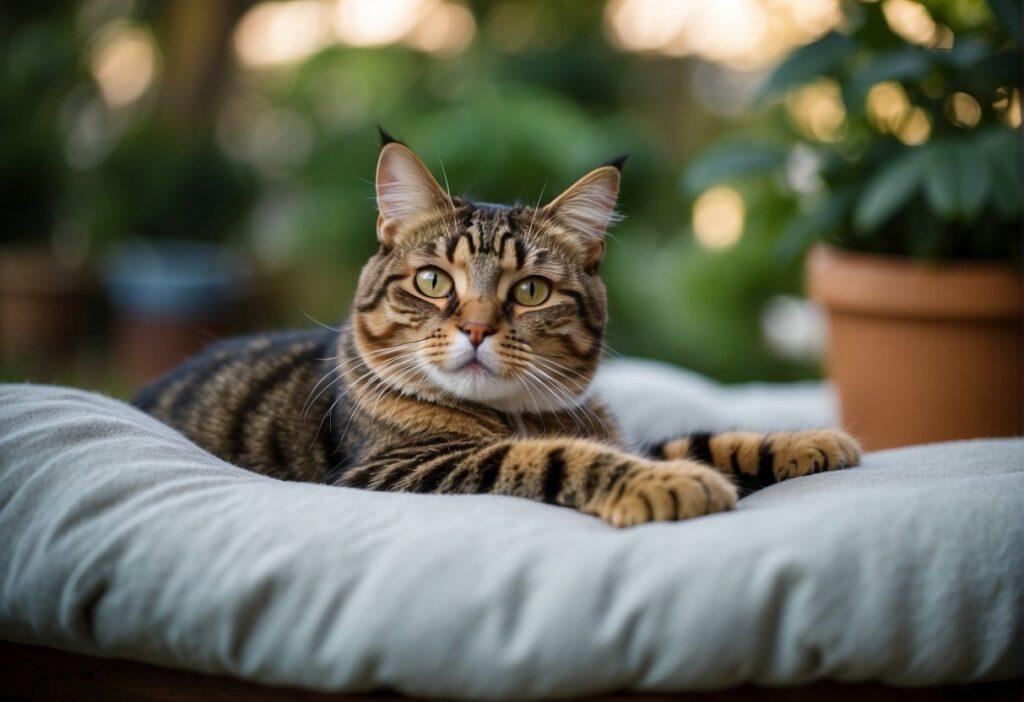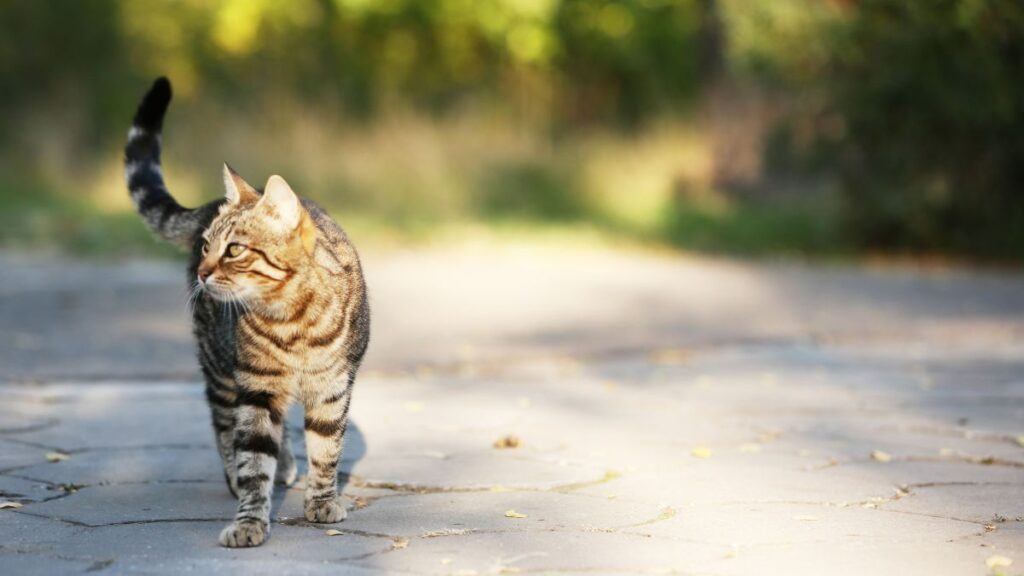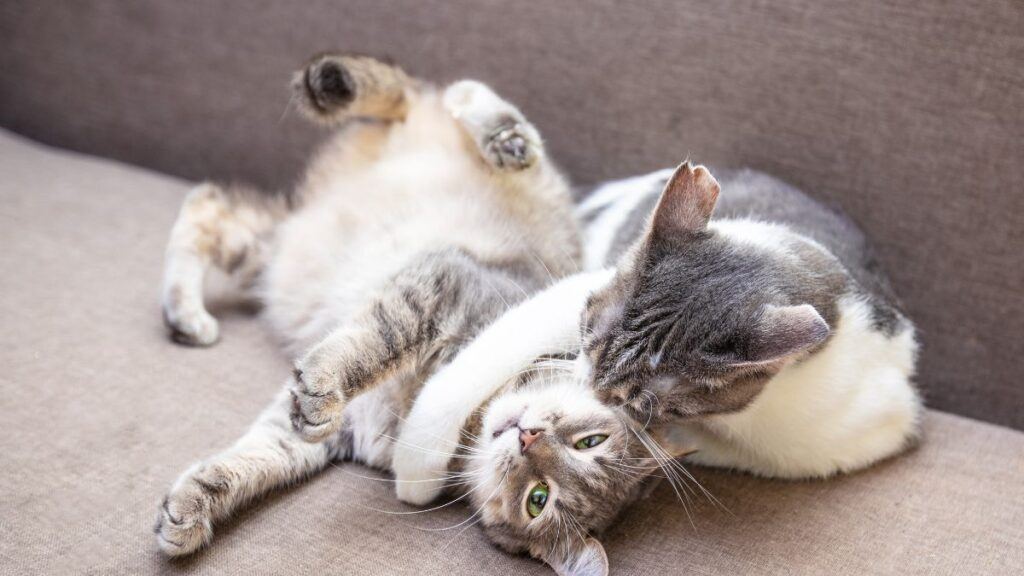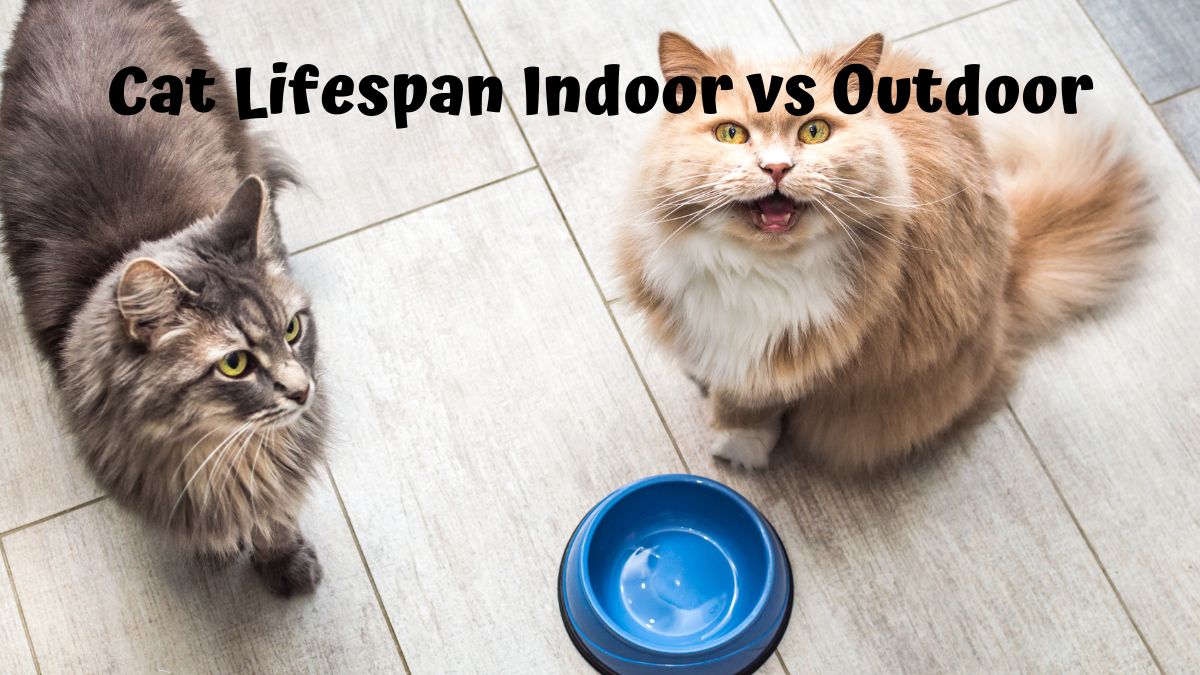The lifespan of a cat can be significantly influenced by the environment in which it is raised.
Indoor cats typically enjoy a longer life due to the controlled environment, free from many dangers that outdoor cats face.
Factors such as disease, traffic, and potential encounters with predators can put outdoor cats at a higher risk, potentially reducing their lifespan.
Indoor cats, on the other hand, benefit from constant access to food, shelter, and care, often resulting in a healthier lifestyle.
Read on as we explore these very different lifestyles of the feline world.
Comparing Lifespans: Indoor Vs Outdoor Cats

Understanding the differences in life expectancy between indoor and outdoor cats is crucial. Several factors contribute to these variances, including exposure to dangers and day-to-day lifestyle.
Average Lifespans and Influencing Factors
Indoor cats typically enjoy a longer life expectancy than their outdoor counterparts, often living 12 to 15 years, with many reaching into their late teens or early twenties.
Key factors influencing the lifespan of indoor cats include steady access to food, preventive health care, and a controlled environment free from the dangers that outdoor cats face.
Outdoor cats face greater risk factors that may impact their longevity.
Life expectancy for outdoor cats, or those with indoor-outdoor access, is significantly reduced, with averages falling around 5 to 7 years.
Exposure to diseases, parasites, and varying weather conditions are contributing factors.
The Role of Predation and Traffic
Predation by wild animals and traffic accidents are among the leading causes of death in outdoor cats.
The likelihood of fatal encounters with vehicles or predators such as coyotes significantly decreases for cats indoors.
The existence of stray and feral cats often tells a story of even harsher conditions.
Strays, once domesticated and now living outdoors, and feral cats born in the wild face constant threats from predation, disease, and traffic, further reducing their life expectancy.
Health Concerns for Indoor and Outdoor Cats

The health and longevity of cats can be influenced by whether they live indoors or outdoors, with different risks associated with each lifestyle.
Common Illnesses and Prevention
Outdoor cats are at a higher risk of contracting infectious diseases such as the feline immunodeficiency virus (FIV) and feline leukemia (FeLV).
Both diseases compromise a cat’s immune system and can lead to secondary infections.
Prevention strategies include keeping cats indoors to avoid interactions with infected felines and regular health check-ups.
- FIV Preventions:
- Keep cat indoors
- Avoid catfights
- Regular veterinary check-ups
- FeLV Preventions:
- Vaccination
- Keep cat indoors
- Regular health screenings
Indoor cats are less exposed to infectious agents but may still face health issues stemming from a less active lifestyle, such as obesity, which can lead to diabetes and arthritis.
- Indoor Cat Care:
- Monitoring diet
- Regular exercise
- Environmental enrichment
Veterinary Care and Vaccinations
Regular veterinary care is pivotal for all cats, regardless of their living environment.
Indoor cats require vaccinations and annual check-ups to monitor for health concerns from a sedentary lifestyle.
Due to their increased exposure to various infectious agents, outdoor cats may need more frequent veterinary check-ups and a stringent vaccination schedule to curtail the rise of infectious diseases.
- Indoor Cat Vaccinations:
- Rabies
- Feline distemper
- Feline herpesvirus
- Outdoor Cat Vaccinations:
- Rabies
- Feline distemper
- Feline herpesvirus
- FeLV
- FIV (if available)
Consistent veterinary care helps detect and manage health issues in indoor and outdoor cats, ensuring a better quality of life.
Safety and Risks in Different Environments

The lifespan of cats can be significantly influenced by their living environment, with various risk factors associated with indoor and outdoor lifestyles.
Hazards of Outdoor Living
Outdoor cats face a wide array of risks. These include potential traffic accidents near busy roads, which can lead to severe injuries.
Outdoor cats are also at risk of intentional poisonings, accidental consumption of toxic plants, and more aggressive interactions with other animals, leading to injuries or illnesses.
Their instincts may lead them to explore unsafe areas or to consume substances that are dangerous to their health.
- Traffic Accidents: Proximity to traffic can result in fatal accidents.
- Intentional Poisonings: Some individuals may intentionally harm cats.
- Toxic Plants: Cats might ingest poisonous plants while exploring.
- Animal Fights: Outdoor cats often encounter other animals, risking injury.
Indoor Safety Precautions
Indoor pets, while generally safer, are not without risks.
Ensuring a safe indoor environment involves removing or securing potential hazards, such as toxic houseplants or household chemicals that a curious cat could ingest.
Regularly checking for small objects that could be swallowed and securing windows and balconies to prevent falls are critical safety measures.
- Secure Windows/Balconies: To prevent falls and escape.
- Remove Toxic Substances: Household cleaners and plants must be out of reach.
- Check for Small Objects: Small items can pose choking hazards.
Creating a safe living space for a cat, indoor or outdoor, requires proactive management of these risks to ensure the safety and longevity of the pet.
Behavioral and Psychological Aspects

Understanding cats’ behavioral and psychological aspects is essential to assessing their quality of life, whether indoors or outdoors.
Mental Stimulation and Happiness
Mental Stimulation: Cats require mental stimulation to lead a happy and healthy life. Indoor environments must often be enriched with toys, scratching posts, and interactive activities to prevent boredom.
Outdoor access typically provides a natural and ever-changing environment that can support a cat’s mental health through exploration and hunting behaviors.
Happiness: The quality of life for a cat can be connected to their happiness levels. Indoor cats may experience less mental stimulation than their outdoor counterparts, potentially affecting their happiness.
However, providing a variety of activities indoors can promote a mentally healthy and happy life.
Stress Factors and Behavioral Issues
Stress Factors: Indoor and outdoor lifestyles present different stressors for cats. Indoor cats may experience stress from confinement or lack of stimulation.
Outdoor cats face stress related to territorial disputes and the threat of predators.
Behavioral Issues: Cats under stress may develop behavioral issues, manifesting as aggression, over-grooming, or inappropriate elimination.
Behavioral problems in indoor cats can arise from a sedentary lifestyle and lack of environmental enrichment, whereas outdoor cats may exhibit behaviors related to survival instincts or territorial defense.
It is crucial to assess each cat’s environment and provide necessary changes to promote their mental stimulation and minimize stress, enhancing their overall behavioral and psychological well-being.
Diet and Nutrition: Indoor Vs Outdoor
The diet and nutrition of cats differ greatly depending on whether they live indoors or outdoors.
Their food sources, nutritional needs, and weight management require careful consideration to maintain their health.
Food Sources and Nutritional Needs
Indoor cats typically have a consistent diet provided by their owners, which can be tailored to include all necessary nutrients for a balanced diet.
High-quality commercial cat foods are specially formulated to meet a cat’s nutritional needs and support a healthy life.
Depending on the specific product, the diet may comprise wet, dry, or a combination of both food types.
Outdoor cats, in contrast, may have a more varied diet due to their tendency to hunt animals and insects, providing them with protein but lacking other vital nutrients in commercial cat food.
Owners must ensure outdoor cats still receive a balanced diet, potentially through a mix of natural prey and supplementation with commercial food to avoid nutritional deficiencies.
Maintaining a Healthy Weight
Indoor cats often live less actively than their outdoor counterparts and are at a higher risk for weight gain.
Controlling portion sizes and balancing proteins, fats, and carbohydrates is key to maintaining a healthy weight for indoor felines.
For outdoor cats, the excess physical activity often promotes a leaner physique but does not exempt them from possible weight issues.
Owners must monitor their outdoor cats’ body condition and adjust their food intake to maintain optimal cat health. Regular veterinary check-ups can help detect any weight concerns early on.
Exercise and Physical Activity

Physical activity is crucial for a cat’s health, impacting indoor and outdoor cats differently due to their distinct living environments.
Outdoor Exercise and Natural Behaviors
Outdoor cats can access the great outdoors, providing a vast roam, climb, and hunt environment.
This setting allows them to engage in natural behaviors, such as chasing prey and climbing trees, which offers excellent physical exercise.
The outdoor lifestyle usually means more opportunities to stay active and fit, as outdoor environments tend to be less predictable and more stimulating.
Exposure to fresh air and sunlight can also contribute to a cat’s well-being.
However, outdoor activities carry risks, such as potential injuries, disease exposure, and increased likelihood of accidents.
Indoor Exercise and Enrichment
Indoor cats rely on their human companions to ensure they get enough exercise, often through cat toys, scratching posts, and cat trees.
Owners can create an engaging indoor environment with plenty of toys to mimic the hunting experience.
Lack of exercise can concern indoor cats, but a well-structured indoor environment, including an enclosed catio, can alleviate this issue.
1 Enclosed catios offer safe outdoor access, allowing indoor cats to experience fresh air and stimulate the outdoor environment while minimizing risks.
Encouraging play and movement within the home is essential to keep indoor cats healthy and prevent obesity.
Caring for the Aging Cat

As cats grow older, their healthcare needs evolve, and their surroundings may require adjustments to maintain their quality of life.
Owners of senior cats need to be diligent in monitoring their health and adapting to their home environment.
Healthcare for Older Cats
Veterinary Check-ups: Regular veterinary exams become increasingly important for older cats.
These should include routine bloodwork, blood pressure measurement, and dental care to monitor for common age-related conditions such as kidney disease, hyperthyroidism, and arthritis.
Since indoor-only cats can miss out on natural stimuli, keeping track of any behavioral changes that could indicate health issues is pivotal.
- Diet and Nutrition: An age-appropriate diet, potentially lower in calories if the cat is less active but rich in essential nutrients, can help manage weight and support joint health. Supplements, such as omega-3 fatty acids, may be recommended by a veterinarian to aid with inflammation and cognitive function.
- Medication Management: If a senior cat is prescribed medications, strict adherence to dosing schedules is crucial. It’s important to monitor for side effects or interactions between different medications.
Adjusting the Environment for an Aging Feline
Accessibility: As cats age, their ability to jump and climb can diminish. Providing steps or ramps to favorite perches and easy access to litter boxes and food/water dishes can help an aging cat retain independence.
- Comfort: Keep a warm and quiet resting space available. Beds with orthopedic support can particularly benefit older cats with joint pain. Maintaining a steady indoor temperature and avoiding drafts can also help elderly felines stay comfortable.
- Stimulation: Provide mental stimulation through interactive toys, puzzle feeders, or window perches to watch the outside world. This helps keep an indoor lifestyle enriching for an indoor senior cat, reducing potential stress caused by a lack of stimulation.
The Debate on Indoor Vs Outdoor: What’s Best for Your Cat?
The choice between keeping a cat indoors or allowing it to explore outdoors is a critical decision for pet owners, playing a significant role in the health and safety of their feline companions.
Perspectives from Cat Owners and Experts
Many cat lovers are convinced that an indoor lifestyle is safer, potentially leading to a longer lifespan for domestic cats.
Indoor environments protect pets from outdoor hazards such as traffic, predators, and diseases.
Experts such as veterinarians and animal welfare groups often support this view, citing statistics that indoor cats live, on average, significantly longer than outdoor cats.
They also note that indoor cats have less exposure to stress from territorial fights and inclement weather.
However, some owners believe outdoor access is crucial for a cat’s mental health and well-being, allowing them to exhibit natural behaviors like hunting and climbing.
This group of pet parents argues that the risks associated with outdoor life can be mitigated with proper vaccinations and precautions.
They also suggest supervised outdoor time or secure cat patios (catios) as compromises that allow cats outdoor stimulation without the full range of threats.
Making the Best Choice for Your Pet
Whether to keep a cat indoors or outdoors should be a well-considered choice for each responsible cat owner. The main difference lies in balancing safety with quality of life.
- Safety: On one hand, indoor living dramatically reduces the risks of accidents, fights, and disease.
- Quality of Life: On the other hand, outdoor access may offer enrichment that some believe contributes to a cat’s overall happiness.
Owners should weigh factors such as local wildlife, traffic levels, and their ability to monitor their cat’s outdoor activities.
It may be a good idea to consult a veterinarian to understand their pet’s potential health implications. Sometimes, leash training or secure outdoor enclosures can provide a middle ground.
No one-size-fits-all answer on whether indoor or outdoor living is best for your cat.
Each cat owner must consider their circumstances, the nature and habits of their pet, and the level of risk they are willing to accept.
Introducing Cory Haasnoot, a devoted father, loving husband, and enthusiastic cat lover. As a key content creator for CatFurLife.com, Cory blends his family values and passion for felines into engaging and informative content. He brings a unique perspective to the site, sharing cat care tips and how cats can enrich family life and bring joy to households.

